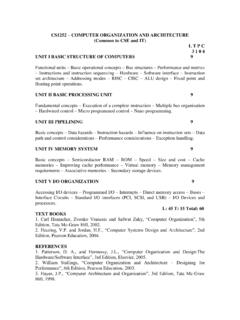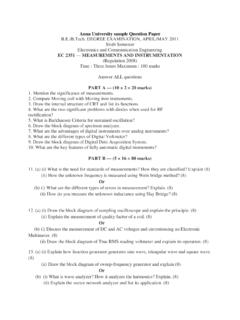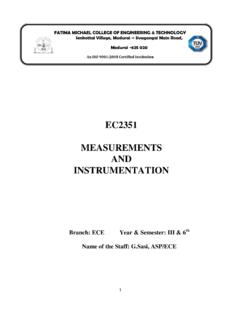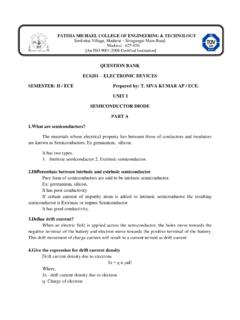Transcription of CE 2031 : Repair and Rehabilitation of Structures
1 CE 2031 : Repair and Rehabilitation of Structures VIII Semester Elective Prepared by Prof. M. Vijayalakshmi Department of Civil Engineering Fatima Michael College of Engineering Madurai 625 020. CE 2071 Repair AND Rehabilitation OF Structures OBJECTIVES: To make the students to gain the knowledge on quality of concrete, durability aspects, causes of deterioration, assessment of distressed Structures , repairing of Structures and demolition procedures. UNIT I MAINTENANCE AND Repair STRATEGIES 9 Maintenance, Repair and Rehabilitation , Facets of Maintenance, importance of Maintenance, Various aspects of Inspection, Assessment procedure for evaluating a damaged structure , causes of deterioration. UNIT II SERVICEABILITY AND DURABILITY OF CONCRETE 9 Quality assurance for concrete Strength, Durability and Thermal properties, of concrete Cracks, different types, causes Effects due to climate, temperature, Sustained elevated temperature, Corrosion - Effects of cover thickness and cracking.
2 UNIT III MATERIALS FOR Repair 9 Special concretes and mortar, concrete chemicals, special elements for accelerated strength gain, Expansive cement, polymer concrete, sulphur infiltrated concrete, Ferro cement, Fibre reinforced concrete. UNIT IV TECHNIQUES FOR Repair AND PROTECTION METHODS 9 Rust eliminators and polymers coating for rebars during Repair , foamed concrete, mortar and dry pack, vacuum concrete, Gunite and Shotcrete, Expoxy injection, Mortar Repair for cracks, shoring and underpinning. Methods of corrosion protection, corrosion inhibitors, corrosion resistant steels, coatings and cathodic protection. Engineered demolition techniques for dilapidated Structures case studies UNIT V Repair , Rehabilitation AND RETROFITTING OF Structures 9 Repairs to overcome low member strength. Deflection, Cracking, Chemical disruption, weathering corrosion, wear, fire, leakage and marine exposure. TOTAL: 45 PERIODS TEXT BOOKS: 1.
3 Denison Campbell, Allen and Harold Roper, Concrete Structures , Materials, Maintenance and Repair , Longman Scientific and Technical UK, 1991. 2. Allen & Edwards , Repair of Concrete Structures , Blakie and Sons, UK, 1987 REFERENCES: 1. Shetty , "Concrete technology - Theory and Practice", and Company, 2008. 2. Dov , " Design and Construction Failures", Galgotia Publications Pvt. Ltd., 2001 3. , , " Structural Health Monitoring, Repair and Rehabilitation of Concrete Structures ", Allied Publishers, 2004. 4. CPWD and Indian Buildings Congress, Hand book on Seismic Retrofit of Buildings, Narosa Publishers, 2008. 5. , "Concrete technology ", McGraw Hill, 2013 Unit I MAINTENANCE AND Repair STRATEGIES Maintenance, Repair and Rehabilitation , Facets of Maintenance, importance of Maintenance, various aspects Inspection, Assessment procedure for evaluating a damaged structure , causes of deterioration. _____ Maintenance : Maintenance is preventive in nature.
4 Activities include inspection and works necessary to fulfill the intended function or to sustain original standard of service. The maintenance of structure is done to meet the following objective Prevention of damages due to natural agencies and to keep them in good appearance and working condition. Repair of the defects occurred in the structure and strengthen them, if necessary. The Maintenance work is broadly classifies as a) Preventive Maintenance b) Remedial Maintenance c) Routine Maintenance d) Special Maintenance a) Preventive Maintenance The maintenance work done before the defects occurred or damage developed in the structure is called preventive maintenance. It includes thorough inspection, planning the programs of maintenance and executing the work It depends upon the specifications, condition and use of structure . b) Remedial Maintenance It is the maintenance done after the defects or damage occurs in the structure . It involves the following basic steps.
5 - Finding the deterioration - Determining the causes - Evaluating the strength of the existing structure - Evaluating the need of the structure - Selecting and implementing the Repair procedure c) Routine Maintenance It is the service maintenance attended to the structure periodically. The nature of work done and interval of time at which it is done depends upon specifications and materials of structure , purpose, intensity and condition of use. It includes white washing, parch Repair to plaster, replacement of fittings and fixtures, binding of road surface. e) Special Maintenance It is the work done under special condition and requires sanction and performed to rectify heavy damage. It may be done for strengthening and updating of the structure to meet the new condition of usage or to increase its serviceability. It may include particular or complete renewal occurring at long interval, such as floors, roofs etc. Necessity of maintenance The causes which necessitate the maintenance effects the service and durability of the structure as follows: a) Atmospheric agencies b) Normal wear and tear c) Failure of structure a) Atmospheric agencies Rain: It is the important source of water, which affects the structure in the following ways; Physical: Dissolving and carrying away minerals as it is universal solvent.
6 Expansion and contraction The materials is subjected to repetitive expansion and contraction while they become wet and dry and develops the stresses. Expansion of water The variation of temperature causes the expansion and contraction absorbed water and affects the micro- Structures of the materials. Erosion Transportation, attrition and abrasion of the materials is quite evident effect of the water. Chemical: The water available in nature contains acids and alkaline and other compound in dissolve form acts over the material to give rise, which is known as chemical weathering. Wind: It is the agent, which transports the abrasive material and assists the physical weathering Its action is aggravated during rains and, When it is moving with high speed, it may contains acidic gases like CO2 fumes which may act over the material and penetrates quite deeply in materials and structure . Temperature: The seasonal and annual variation of the temperature, difference in temperature in two parts of the materials and the surface of material causes expansion and contraction, this movement of the material bond and adhesion between them is lost when it is repeated.
7 This responsible for the development of cracks and the rocks may break away into small units. Exploitation or peeling off the shell takes place if exterior layer are heated externally with respect to internal layers. The temperature variation may also cause change in the structure and chemical composition of the material. b) Normal Wear and tear During the use of structure it is subjected to abrasion and thereby it looses appearance an serviceability. c) Failure of structure Failure is defined as the behavior of structure not in agreement with expected condition of stability or lacking freedom from necessary Repair or non-compliance with desired use of and occupancy of the completed structure . In field it may result in visual collapse of the structure or even suspension of the services the collapse of towers, sliding or over turning of dam, settlement of foundation, crushing of columns etc. The causes of failure may be broadly grouped as: Improper Design: Due to incorrect, insufficient data regarding use, loading and environmental conditions, selection of material and poor detailing.
8 Defective Construction: Poor materials, poor workmanship, lack of quality control and supervision. Improper use of structure : Overloading, selecting the structure for the use for which they are not designed such as deteriorating environment due to impurities from industrial fuel burning, sea water minerals, chemicals, storage of chemicals etc. Lack of maintenance: Lack of upkeep, proper protection, precaution and preservation, deteriorated the structure , which may result in the failure. Facets of maintenance: Maintenance operations have many facets such as a) Emergency maintenance: Necessitated by unforeseen breakdown drainage or damage caused by natural calamity like fire, floods, cyclone earthquake etc. b) Condition Based maintenance: Work initiated after due inspection c) Fixed time maintenance: Activities repeated at predetermined intervals of time. d) Preventive maintenance: This is intended to preserve by preventing failure and detecting incipient faults (Work is done before failure takes place) e) Opportunity maintenance: Work did as and when possible within the limits of operation demand.
9 F) Day-to-Day care and maintenance g) Shut down maintenance: Thorough overhaul and maintenance after closing a facility. h) Improvement plans: This is essentially maintenance operation wherein the weak links in the original construction are either replaced by new parts or strengthened. Importance of Maintenance Improves the life of structure Improved life period gives better return on investment Better appearance and aesthetically appealing Better serviceability of elements and components Leads to quicker detection of defects and hence remedial measures Prevents major deterioration and leading to collapse Ensures safety to occupants Ensures feeling of confidence on the user Maintenance is a continuous cycle involves every element of building science namely Structural Electrical wiring Plumbing-water-supply-sanitation Finishes in floors and walls Roof terrace Service platform/verandah Lifts Doors windows and other elements Various aspects Inspection.
10 The following are the various maintenance aspects, a) Daily Routine Maintenance b) Weekly Routine Maintenance c) Monthly Routine Maintenance d) Yearly Routine Maintenance a) Daily Routine Maintenance Basically an inspection oriented and may not contain action to be taken Help in identifying major changes, development of cracks, identifying new cracks etc Inspection of all essential items by visual observation Check on proper function of sewer, water lines, wash basins, sinks etc Check on drain pipes from roof during rainy season. b) Weekly Routing Maintenance Electrical accessories Cob webs cleaning Flushing sewer line Leakage of water ling c) Monthly Routing Maintenance Cleaning doors, windows latches etc Checking septic tank/ sewer Observation for cracks in the elements Cleaning of overhead tanks Peeling of plaster, dampness, floor cracks d) Yearly Routing Maintenance Attending to small repairs and white washing Painting of steel components exposed to weather Check of displacements and remedial measures Repair Repair is the technical aspect of Rehabilitation .



